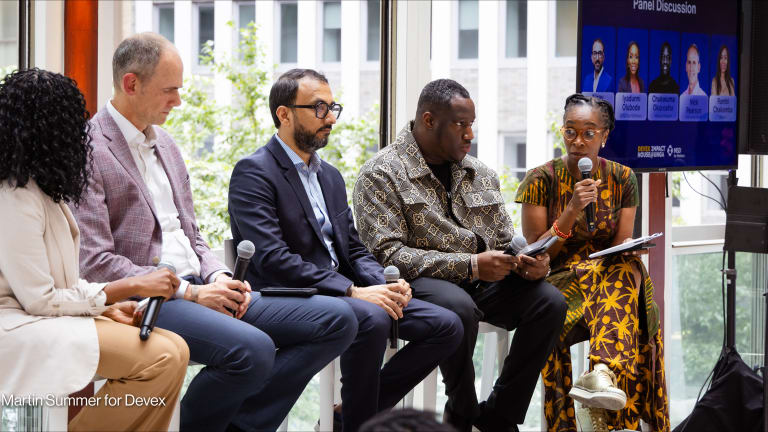
More data. Better data. Accessible data. These are the rallying cries heard today by the global health community. The call for data is particularly important in places like Bihar, India, where data insights help the State Government determine where to invest limited resources and effort. The enthusiasm around data-driven decision making in health care isn’t without risk: We may only see modest benefit if data systems are created and run in silos, missing the opportunity for the transformational change these challenges demand.
CARE and IBM teamed up with the government of Bihar to make “data integration” more than a buzzword. Factoring in all sorts of issues such as governance, privacy, differing standards, and data quality, we worked to enable significant progress through a focused, high-intensity intervention.
“With master data management architecture, you can improve data completeness and quality.”
—Bihar is a state of India with a population of more than 100 million — roughly the size of the Philippines — where 34 percent live in poverty. The availability of medicines in public health facilities ranges between 30-50 percent at best. A primary driver of this access challenge is that data on drug procurement and distribution live in one system, and data on drug consumption live in another. This siloed data inhibits decision-makers from easily identifying how to ensure adequate and efficient supply and delivery of essential medications.
For example, drug forecasting in Bihar typically is a loose estimation, resulting in some clinics throwing away expired drugs while others face stockouts. The public ultimately suffers when patients must go to private pharmacies, paying for drugs that otherwise should have been provided at no cost. In Bihar, 70 percent of households’ health out-of-pocket expenditure is incurred on medication.
CARE India and IBM Health Corps partnered with the government to demonstrate what data integration for public health actually means. Using a rapid prototyping approach, the IBM and CARE teams built a proof-of-concept platform to integrate the two data systems and use data visualization to support user interaction around the outputs. Among other things, these insights and visualizations could help enable decision-makers to more accurately forecast drug consumption and adjust procurement accordingly, thus decreasing stockouts, waste, and out of pocket costs for patients.
Our teams have seven lessons learned to share with other organizations on their journey to data-driven decision-making:
1. Start with the right question
Data integration isn’t an end, but rather, a means. There is a question about how to increase access to care, ensure higher-quality care, and reduce costs, and data integration helps us answer that question. To ensure we had identified the right question, IBM and CARE started with a series of consultations with key stakeholders in the system. We focused our conversations on the key performance indicators these stakeholders wanted to achieve, rather than the details of the data components. This grounded our data integration effort with purpose and multisector alignment. IBM Design Thinking was used as a framework to assist in this process.
2. Avoid disruption of current data systems
In the early stages of data integration, the owners of the disparate data systems may be resistant to making changes directly in their applications. Not only can those changes be time-intensive, but those efforts may distract analysts and developers from serving the users they are accountable to. The platform we designed includes a data landing zone where the data can be regularly fed in; we did not have to change the original data systems themselves. Analytics could then be applied to the data accumulated in the data reservoir. This shows “integration” can happen outside the confines of the original data systems.
3. Establish a common data dictionary
A common issue when merging datasets is that data is captured differently in each platform. In our case, when we went through the two data systems, there were variations in what the drugs were called. We established the “Essential Drug List” as the common data dictionary for all integrated data sets. With master data management architecture, you can improve data completeness and quality, and eventually reduce manual data entry and cleaning as well.
4. You don’t necessarily need ‘big data’ to get started
The quantity and level of granularity needed in the data depend on the scope of the questions being answered. In our case, we did not have transaction-level data for drug procurement and distribution. However, this was not an impediment when developing the analytics models. We could still compare drug distribution with consumption for each district by using the aggregate data.
5. When it comes to data visualization, don’t just show data, provide context
To empower decision-makers, we designed an easy-to-understand, graphical representation to give meaning to the data presented. For example, when comparing drug consumption to distribution for one district, we provided a weighted average of other districts, which was based on the number of health centers in the district. Looking at a district’s performance versus the average of all districts is not that relevant when they vary significantly in population size. This contextual clue helped make the comparison more digestible.
6. Data dashboards are only as valuable as the actions they provoke.
Showing the historical drug consumption for a district was helpful, but what could make it even more actionable was a time-series forecasting model to generate an estimated drug consumption figure for the next three months. This could allow the civil surgeon to factor in this prediction, while generating future requests for a specific drug. We also added an automated download option for drug ordering, to make the process even more seamless.
7. Identify the easy-to-fill data gaps
We noted that only the drugs that were prescribed and issued were being captured in the outpatient data system. But if all drugs prescribed — even those not fulfilled — are documented, we can better identify where patients may be forced to pay out of pocket for needed medications. Updating this component of data entry is not very disruptive to the outpatient department clerk’s workflow, but can provide valuable insight into the key questions being asked.
The journey to becoming a data-driven community need not start with expensive technologies. These relatively simple steps can be adopted by nearly any organization heeding the call for data. With the right questions and right design principles underscoring the journey, we can position ourselves for greater insight and value from all the data generated across the public health field.
As complicated as the technology issues may be at times, the impact of this work is simply to help the people of Bihar — particularly its mothers and children — live healthier, more productive lives.









